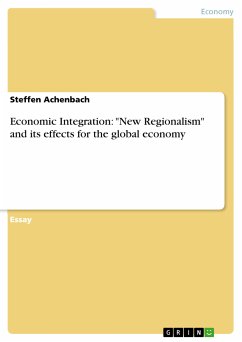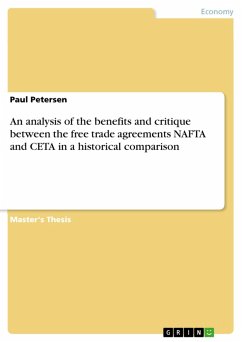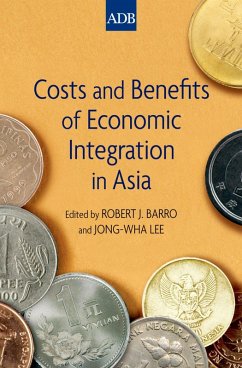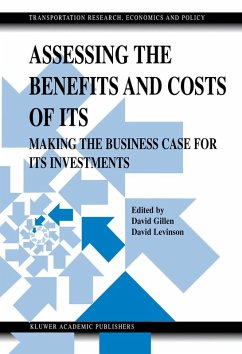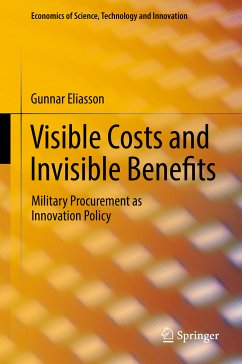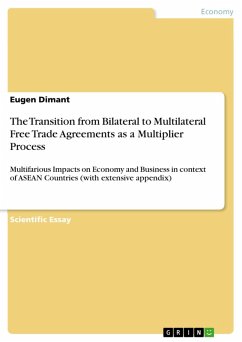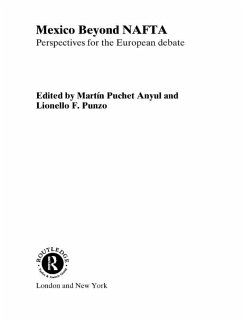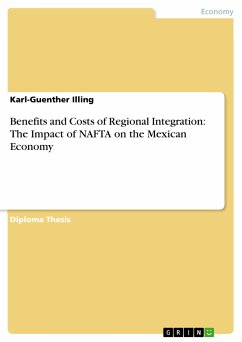
Benefits and Costs of Regional Integration: The Impact of NAFTA on the Mexican Economy (eBook, PDF)

PAYBACK Punkte
0 °P sammeln!
Diploma Thesis from the year 2004 in the subject Economics - Foreign Trade Theory, Trade Policy, grade: 1,3 (A), European Business School - International University Schloß Reichartshausen Oestrich-Winkel (Economic Policy and Political Economy), language: English, abstract: In January 1994, after two and a half years of negotiation, the North American Free Trade Agreement (NAFTA) came into force. The treaty between Canada, Mexico and the United States has created the largest economic area in the world, slightly surpassing the European Union in market size. But NAFTA is also outstanding in a se...
Diploma Thesis from the year 2004 in the subject Economics - Foreign Trade Theory, Trade Policy, grade: 1,3 (A), European Business School - International University Schloß Reichartshausen Oestrich-Winkel (Economic Policy and Political Economy), language: English, abstract: In January 1994, after two and a half years of negotiation, the North American Free Trade Agreement (NAFTA) came into force. The treaty between Canada, Mexico and the United States has created the largest economic area in the world, slightly surpassing the European Union in market size. But NAFTA is also outstanding in a second aspect: it has constituted the first major regional integration arrangement between two highly developed countries, the United States and Canada, and a developing country, Mexico. The North-South nature of North American integration has polarized the debate about NAFTA from the earliest stage on. On the one hand it was unclear how much the U.S. would gain from the agreement. Would it stabilize its southern neighbor and thus benefit the U.S. economically and politically? Or would it cause the "giant sucking sound" Ross Perot feared, drawing thousands of jobs from the U.S. over the border (Thorbecke/Eigen-Zucchi 2002, p. 648)? Regarding these concerns, Canada was at most a side-player, possessing neither intense trade relations nor geographical proximity to Mexico. Mexico's gains from NAFTA, on the other hand, seemed even more unsure. The agreement's effects on the southern member state, whether positive or negative, were expected to be unequally greater than on the U.S. On the one hand, it seemed, Mexico could gain immensely through improved access to the North American market, increasing trade, attracting foreign investment, and importing growth and stability. On the other hand, some trade economists, such as Arvind Panagaria (1996, pp. 512-513) warned that Mexico could only lose when opening its market to its powerful northern neighbors, while receiving little in return that it would not have obtained anyway. Furthermore, would Mexico's move towards regional integration hamper any further step into the direction of multilateral opening, after promising reforms had been started in the mid-1980s? Concerns also regarded the adverse effects of NAFTA within Mexico. These centered around large adjustment costs from sectoral restructuring and resource reallocation. This would occur if inefficient, partly subsidized Mexican industries declined after removing tariffs and non-tariff barriers, allowing the North American competition to enter the national market. In addition, would this hit mostly those Mexican regions that were poor anyway?
Dieser Download kann aus rechtlichen Gründen nur mit Rechnungsadresse in A, B, BG, CY, CZ, D, DK, EW, E, FIN, F, GR, HR, H, IRL, I, LT, L, LR, M, NL, PL, P, R, S, SLO, SK ausgeliefert werden.




